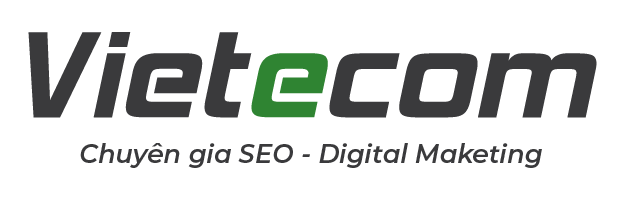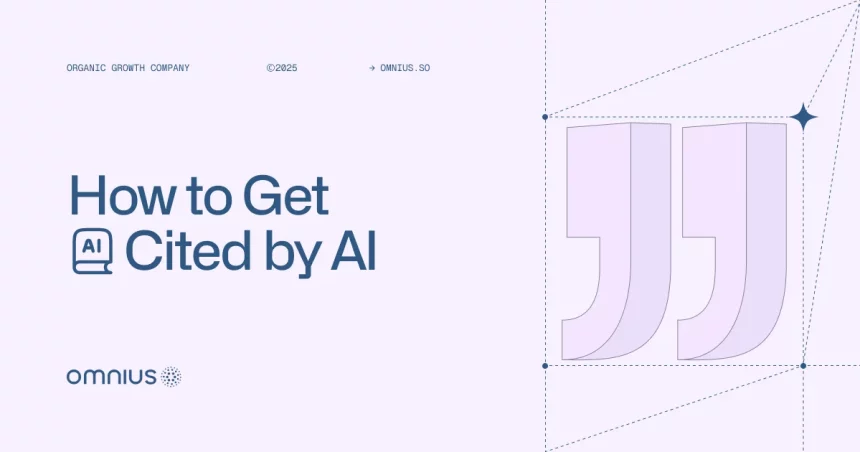As users shift from traditional search engines to generative AI platforms like ChatGPT, Google Gemini, and Perplexity, the way content is discovered is fundamentally changing.
Instead of SERP results, users now receive synthesized answers, and within those answers, only a handful of sources are cited.

If your brand isn’t one of them, you’re invisible in the most important emerging discovery channels.
For SaaS and fintech companies, this presents a massive opportunity to establish authority early.
Being cited by AI search engines not only boosts brand trust but also influences purchasing decisions directly at the top of the funnel.
As proof of this, we at Omnius are seeing this daily with our clients:
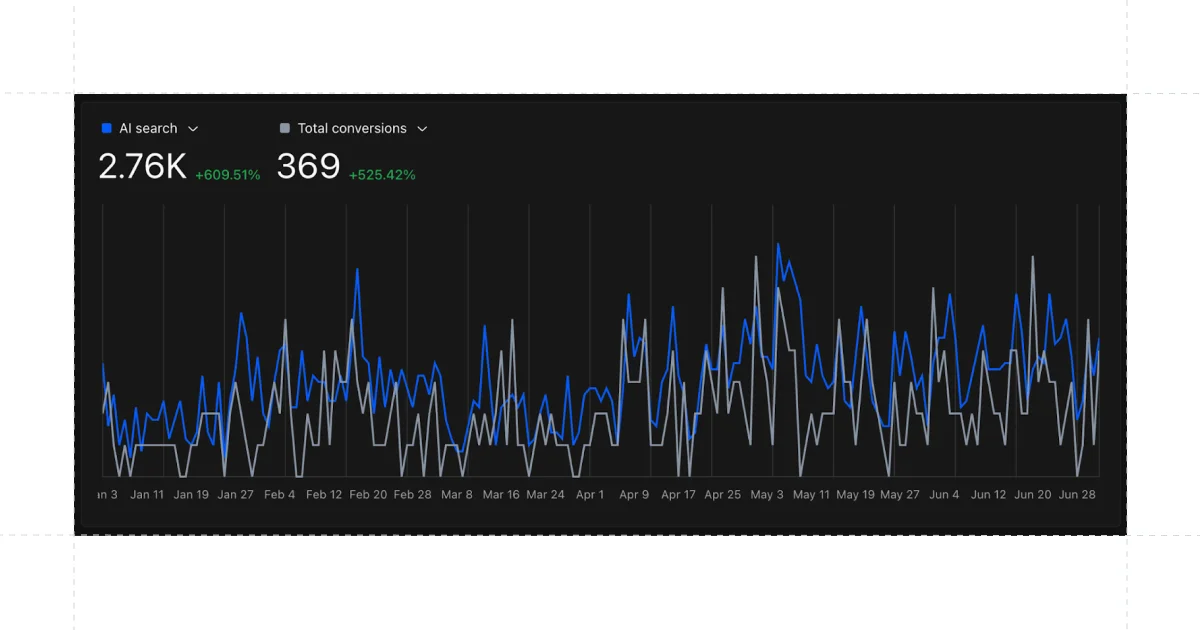
Whether you’re offering payroll automation software or an AI-driven compliance tool, an AI citation positions you as the expert instantly.
Understanding how AI systems select and cite sources is the first step to building your “answer engine” presence and future-proofing your content strategy.
That’s what I’ve covered within this content piece to help you position your business.
Let’s begin.
Why AI Citations Matter in 2025
In traditional search, your goal is to rank on the first page of results.
In 2025, the goal is to be the source that AI pulls from when answering queries.
That’s what we call Answer Engine Optimization – and it requires new thinking.
Unlike traditional SEO, where rankings can fluctuate and click-through rates vary, an AI citation often appears in the direct response to a user’s question.
It’s not just a ranking, it’s a recommendation.
Whether you’re a fintech startup offering AML tools or a SaaS brand building HR automation software, getting cited by AI:
- Puts your content directly into AI-generated answers
- Positions your brand as a trusted industry authority
Influences buyers earlier in their decision journey
While SERP rankings can shift daily, AI citations often persist across thousands of prompts.
Once your content becomes a trusted reference, it can drive long-term awareness without relying on paid ads or keyword bidding.
Data from Real-World AI Citations
After analyzing over AI citations across ChatGPT, Gemini, and other LLM platforms, a clear pattern emerges: AI agents are selective, and their preferences differ by platform, vertical, and content structure.
The data, originally sourced from Session Interactive and Search Engine Land, reveals that Wikipedia, Reddit, and government websites still dominate citations, but specialized content from SaaS and fintech brands is gaining ground.
Especially in B2B, long-form blog posts with clear headings, original research, and expert quotes are frequently referenced in AI-generated responses.
Conversely, product pages, affiliate content, and overly salesy assets rarely make the cut.
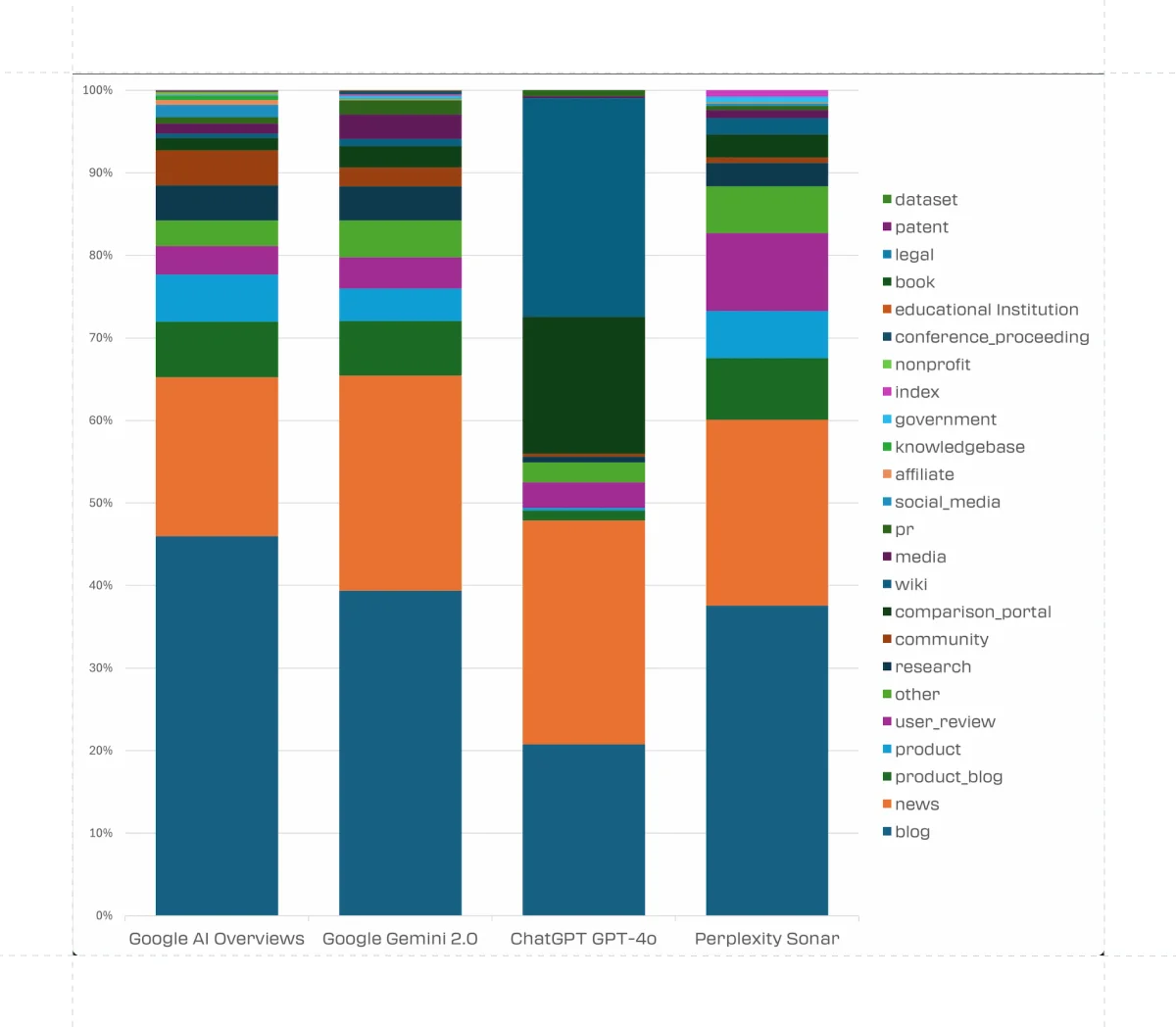
What stands out is the shift toward format and intent. Here’s how:
- ChatGPT favors step-by-step explanations
- Gemini leans into listicles and schema-tagged content, and
- Perplexity pulls heavily from concise, bullet-point summaries and data-backed sources.
For fintech marketers, this means that publishing a detailed guide on “How to streamline expense reporting with real-time data” or a comparison piece like “Top 5 AML compliance tools for startups” with structured data and clear answers drastically increases your chance of being cited.
The AI citation isn’t just about SEO. It’s about anticipating how machines interpret authority, and creating content that machines trust and humans value.
What Makes Content Citation‑Worthy for AI
If you want to be cited by AI platforms like ChatGPT or Gemini, you need to understand what these engines value most when selecting sources.
It’s not just about keyword matching anymore – it’s about trust, structure, and clarity.
Key Traits of Citation-Worthy Content
- Authority & Trust Signals – AI models gravitate toward content from domains with high authority. This includes expert bios, company credentials, and transparent editorial processes. For fintech brands, this means showcasing your certifications (e.g. SOC 2, PCI DSS) or linking to government regulatory bodies.
- Freshness & Relevance – AI favors up-to-date sources. Update high-performing blog posts quarterly and add data from recent reports. A SaaS brand publishing a “2025 Payroll Benchmark Report” will stand out.
- Structured Content – Use schema markup (HowTo, FAQ, QAPage), bulleted lists, and clear H2s. This makes your content easier for LLMs to parse and cite. For example, a page titled “Step-by-Step Guide to AML Compliance” with FAQ schema is more likely to be cited than a generic services page.
- Unique, Non-AI Language – Avoid generic phrasing. AI tools reward originality – first-party data, customer stories, and proprietary frameworks get prioritized.
By aligning your content with these traits, you’re not just optimizing for Google – you’re speaking AI’s language.
Understand AI Engine Behavior: Tailor Your Content for Maximum Citability
Each AI engine has its own “citation algorithm,” and recognizing those nuances is critical if you want your content to be surfaced and trusted in AI-generated answers.
Whether you’re running a SaaS startup or scaling a fintech product, aligning with the preferences of each AI system will give you a competitive edge in the AI visibility race.
1. ChatGPT (GPT‑4o): The Authority Seeker
How it thinks:
According to Profound case study, ChatGPT prioritizes well-established, fact-based sources with institutional authority. It leans heavily toward encyclopedic entries, major media outlets, and structured reference content.
Sourcing behavior:
- Wikipedia: 47.9% of citations
- Reddit: 11.3%
- Forbes: 6.8%
- G2: 6.7%. Etc.

What SaaS/fintech brands should do:
- Get featured in neutral, third-party publications like industry news sites or independent tech roundups.
- Build a presence on Wikipedia or work with partners who maintain pages that reference your brand.
- Avoid over-relying on your blog for citations – ChatGPT prefers third-party validation over self-promotion.
Practical example:
If you’re a B2B SaaS company offering invoice automation, get included in a comparison article on “Top 5 Invoice Tools for Enterprises” published on TechCrunch or a relevant government fintech hub.
2. Google Gemini (2.0 Flash): The Balanced Synthesizer
How it thinks:
Gemini blends blog content, professional reviews, and media like YouTube, offering a broader lens. It values both expert insights and peer validation.
Sourcing behavior based on SearchEngineLand research:
- Blogs: ~39% (e.g., Zapier ~2%)
- News publications: ~26% (PCMag ~2%, Forbes ~2%)
- YouTube: ~3% (highest single-domain citation)
- Community/UGC: ~2%
- Wikipedia: Present, but far less dominant
What SaaS/fintech brands should do:
- Publish in-depth blog posts that walk through real use cases or industry pain points.
- Create or collaborate on YouTube content – tutorials, explainers, or customer success stories.
- Pitch to authoritative media outlets that cover your vertical, such as Forbes Finance Council or PCMag.
Practical example:
A fintech app offering budgeting tools might publish a YouTube explainer titled “How to Automate Business Budgets with AI,” while also guest-posting on Zapier’s blog with practical integrations.
3. Perplexity AI (Sonar Mode): The Expert Curator
How it thinks:
Perplexity acts like a research assistant – it favors deep, factual content and reputable review platforms, often varying its preferences based on query context.
Sourcing behavior:
- Blog/editorial content: ~38%
- News: ~23%
- Product blogs: ~7%
- Expert review sites: ~9% (e.g., NerdWallet, Investopedia, Consumer Reports)
- Community content: Selective, varies by industry
What SaaS/fintech brands should do:
- Aim to be reviewed or cited on trusted niche sites like G2, Capterra, NerdWallet, or Investopedia.
- Publish original research such as benchmarks, ROI calculators, or trend reports.
- Write comparison posts with real data (e.g., “X vs. Y Compliance Platforms for SMEs”).
Practical example:
A regtech startup could publish a data-backed article comparing KYC requirements across countries and ensure it’s shared or cited by outlets like Compliance Week or Investopedia.
4. Google AI Overviews: The Broad Aggregator
How it thinks:
AI Overviews source from the full spectrum of Google Search – including blogs, forums, LinkedIn, Reddit, and YouTube. It values well-structured, deep content over homepage links or thin landing pages.
Sourcing behavior:
- Blog articles: ~46%
- News: ~20%
- Reddit (most cited individual domain): >4%
- YouTube and Quora: Frequent
- LinkedIn articles: 4th most-cited source
- Product/vendor-authored blogs: ~7%
- Wikipedia:
What SaaS/fintech brands should do:
- Focus on rich, evergreen content like listicles, step-by-step guides, and case studies.
- Engage in expert-driven communities (e.g., LinkedIn discussions or Reddit threads).
- Ensure your blog posts are detailed, scannable, and deeply nested in your site hierarchy with contextual breadcrumbs.
Practical example:
A startup offering a lending API might contribute to a Reddit thread on small business financing, post a LinkedIn breakdown of open banking trends, and write a detailed blog guide titled “How to Integrate SME Loan Products via API.”
Think of each AI engine like a different editor at a publication:
- ChatGPT wants sources with long-standing credibility.
Gemini wants to see both expert and practical content. - Perplexity wants specialists with depth and data.
- Google AI Overviews wants a content ecosystem – blogs, voices, and real discussions.
For example, ChatGPT shows a clear preference for Wikipedia” when citing sources (47.9% of citations within the top 10 most-cited sources, vs. 5.7% in Google AI Overviews and not reaching the top 10 in Perplexity.
The more you tailor your strategy to these personalities, the more likely your brand is to become a cited authority across multiple AI environments.
Ranking Competitive Gaps & What Others Missed
While many SEO blogs are beginning to talk about “how to get cited by AI,” most fail to offer practical, data-driven strategies tailored to specific industries – especially for SaaS and fintech marketers.
What Other Guides Are Missing
- Lack of First-Party Data – Most articles rehash general SEO best practices without showing why certain content gets cited. They don’t analyze real citation data or explain how to tailor content for different LLMs.
- No Framework for Technical Setup – Few guides mention critical components like setting up llms.txt (the LLM equivalent of robots.txt), implementing proper schema types, or optimizing meta descriptions for AI summaries.
- Minimal Industry-Specific Advice – There’s little advice on how B2B SaaS firms or fintech platforms – which often publish in-depth guides, use gated content, or rely on compliance language – can adjust their content strategy for generative engines.
By addressing these gaps, your brand can avoid more generic content.
A fintech company publishing a 2,000-word guide on “How Real-Time KYC Affects Customer Onboarding”, paired with HowTo schema and expert quotes, is far more likely to earn AI citations than a surface-level blog post.
Step‑by‑Step Framework to Get Cited by AI Platforms
Getting cited by AI isn’t just about having good content – it’s about creating content that AI can understand, trust, and extract. Below is a five-part framework you can implement today to start earning AI-generated mentions in tools like ChatGPT, Gemini, and Perplexity.
1. Lay the SEO Foundation
Before AI models can cite your content, they need to find it, and they often rely on the top-ranking results from Google and Bing. That’s why traditional SEO is still the first step. Here’s how to maintain it:
- Ensure your technical SEO is solid (clean URL structures, fast page speed, mobile-optimized layouts, and a strong backlink profile).
- Establish Generative Engine Optimization (GEO) & AEO foundations (structured data, FAQs, llms.txt)
For fintech companies, this might mean earning links from regulators, government portals, or industry alliances.
For SaaS, high-authority reviews and product comparison pages are key. If you don’t rank, AI won’t cite.
2. Build Topical Authority Around a Niche
Generative models are more likely to pull from sites that consistently publish on a specific topic. Don’t chase broad keywords.
Instead, go deep.
If you’re a SaaS tool for employee expenses, build out a content cluster around topics like “automated reimbursements,” “multi-country payroll,” or “ATO reporting for startups.”
Fintech brands offering lending platforms could dominate themes like “BNPL compliance” or “open banking integrations.”
This focused topical authority increases your perceived expertise in the eyes of both humans and machines.
For more info, you can check out our article about how to rank on ChatGPT.
3. Use Structured Data and llms.txt
Schema markup (like HowTo, QAPage, and FAQ) helps machines understand your content structure.
Here’s how it looks:
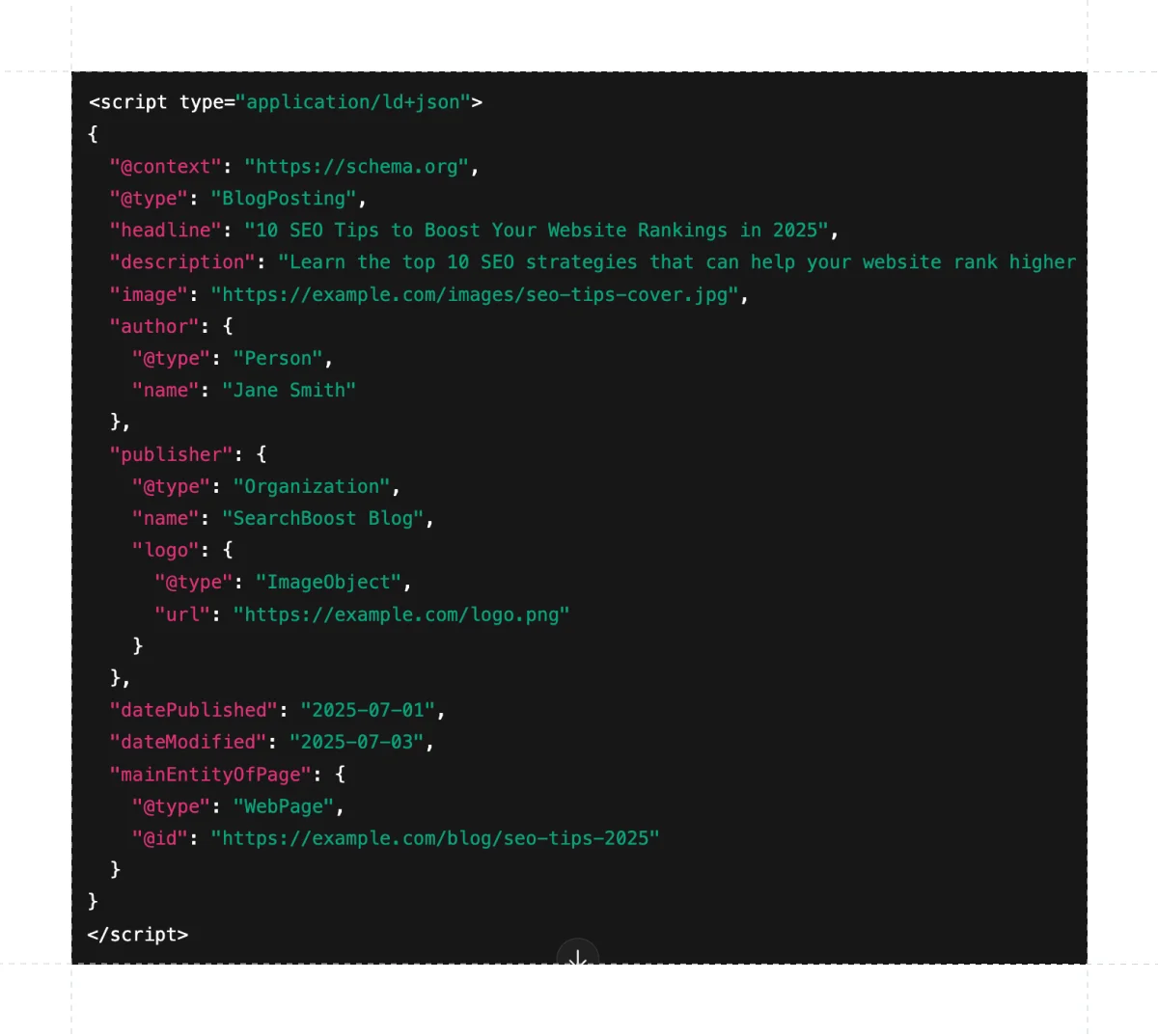
But now, with the rise of LLMs, you also need to create an LLMs.txt file – an emerging standard that works like robots.txt but specifically for AI crawlers.
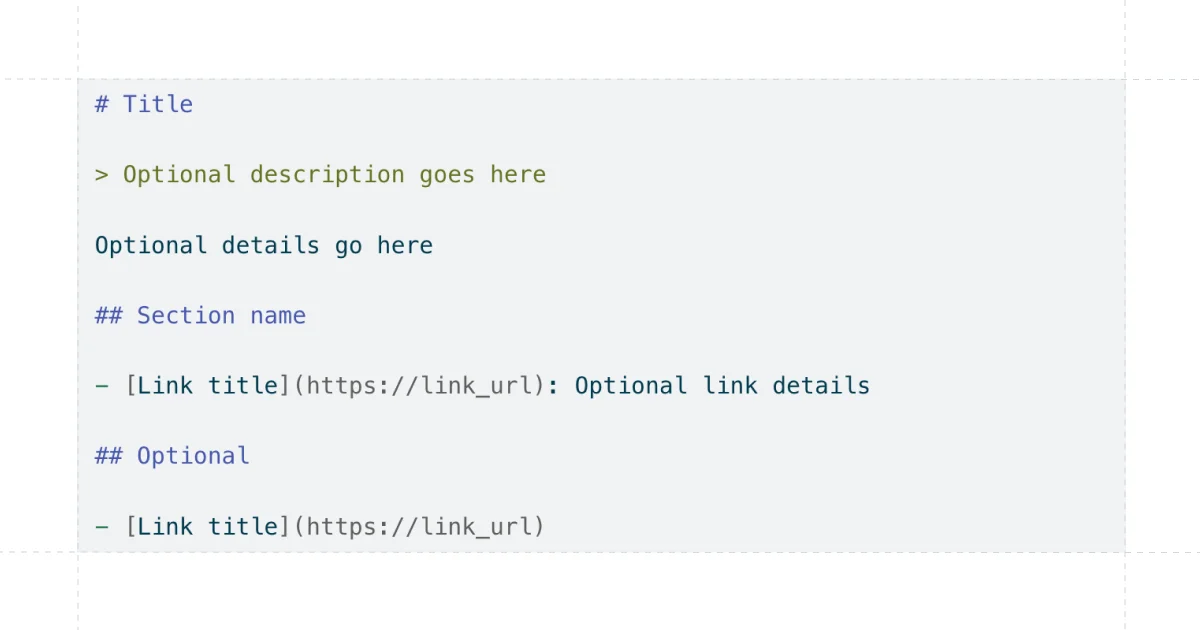
This file tells models like ChatGPT which pages they’re allowed to use and can increase the odds that your most valuable pages get seen and cited.
How to implement them?
Prioritize adding structured data to your core educational or data-rich pages, especially if they answer common user questions.
4. Format Content for Answer Engines
LLMs like ChatGPT, Perplexity, and Google’s AI Overviews thrive on clarity.
They favor content that mirrors how users phrase questions – and how humans respond in conversation.
That means your formatting isn’t just about looking good – it directly influences your chances of being cited or featured.
To maximize your visibility:
1. Use H2s and H3s That Mimic Natural Language Questions
Structure your subheadings as questions people are likely to ask.
- Fintech example: “What is the difference between AML and KYC?”
- SaaS example: “How do I integrate your API with Zapier?”
This improves scannability and makes it easier for LLMs and search engines to extract direct answers.
2. Start With a Concise, Direct Answer
After the heading, open with a short 1–2 sentence summary that directly answers the question. Think of it as your chance to win a featured snippet or be selected by an AI engine for a quick citation.
3. Use Bullet Points, Numbered Steps, or Tables
Follow the summary with:
- Bullet points for lists, feature breakdowns, or pros/cons
- Numbered steps for guides or tutorials
- Tables for comparisons or structured data
4. Keep Paragraphs Short and Conversational
Stick to 2–4 line paragraphs max. This makes your content easier to parse – not only for humans but also for LLMs parsing for summaries.
5. Include Schema Markup Where Possible
For advanced optimization, add FAQPage or HowTo schema to help both Google and AI bots identify structured answers.
Bonus Benefit: This format not only improves your AI discoverability – it also boosts your chances of winning Google Featured Snippets, People Also Ask boxes, and zero-click answers.
5. Showcase Original Data and Expertise
AI models are hungry for trustworthy, unique insights, not recycled summaries. When answering user queries, they prioritize first-party data, proprietary research, and expert commentary over generic content. That’s why showcasing your brand’s unique perspective gives you a major edge.
This isn’t just about thought leadership – it’s about feeding AI engines the kind of credible, structured knowledge they’re trained to cite.
Example: A CRM platform publishes a report on “Average B2B Sales Cycle Lengths by Industry” based on 2,000+ anonymized customer accounts.
How to do it for your business:
1. Tap Internal Data Sources
Identify metrics you already collect, such as user behavior, product usage, conversion funnels, ticket resolution times, fraud trends, lending volumes, etc. These are goldmines for unique content.
2. Create Reports Based on Internal Data
Turn this raw data into compelling reports:
- Monthly/quarterly benchmarks
- Industry-specific trends
- Year-in-review summaries
- Product usage patterns
Make sure to include clear visualizations (charts, graphs, tables) and contextual analysis from your team.
Note: These reports often earn backlinks, media coverage, and citations from both journalists and LLMs.
3. Add Expert Commentary
Layer your data with insights from in-house experts or trusted partners. Add quotes from your CEO, Head of Risk, or Data Science Lead – this builds authority and signals credibility.
4. Package Your Data for Sharing
Create:
- A downloadable PDF report
- A blog summary post
- Short data graphics for social media
- Embed code for charts or tables
This multiplies distribution and makes it easier for AI tools and journalists to reference your work.
5. Submit to High-Authority Outlets
Republish the insights (or a version of them) on industry sites, newsletters, or even Wikipedia. This builds authority signals that LLMs recognize, especially if you link back to the original data source on your domain.
Measure Citation Growth Within AI Platforms
If you want to earn AI citations, you also need a way to track them.
Unlike traditional SEO, where tools like Google Search Console or Ahrefs show you impressions and rankings, monitoring AI citations requires a new approach.
Here’s what you should measure:
1. Citations in ChatGPT, Gemini, and Perplexity
Start by manually prompting these engines with your target keywords (e.g., “best expense management tools for startups” or “what is AML compliance?”) and look for your brand or URL in the cited results.
Some platforms like Perplexity explicitly list citations. Others, like ChatGPT, may require a Plus account and use of “Browse with Bing.”
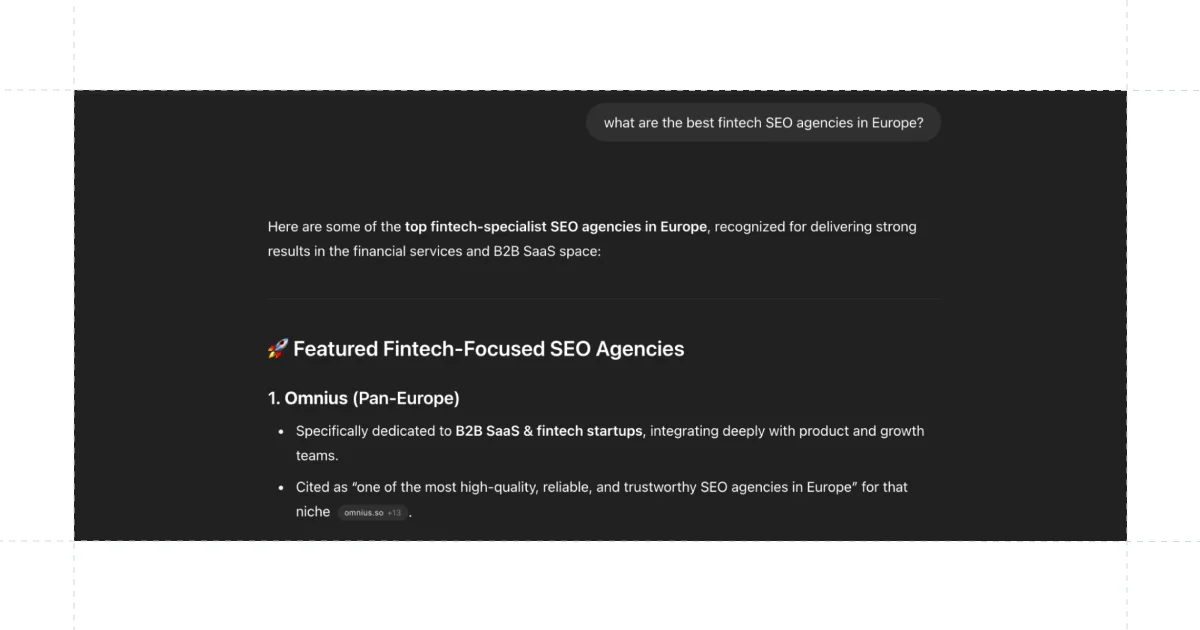
2. Featured Mentions in AI Overviews (Google)
Google’s AI Overviews often link directly to a few sources.
Track whether your content appears as a linked answer in featured boxes using visual spot checks, but make sure to use Incognito mode for relevant results.
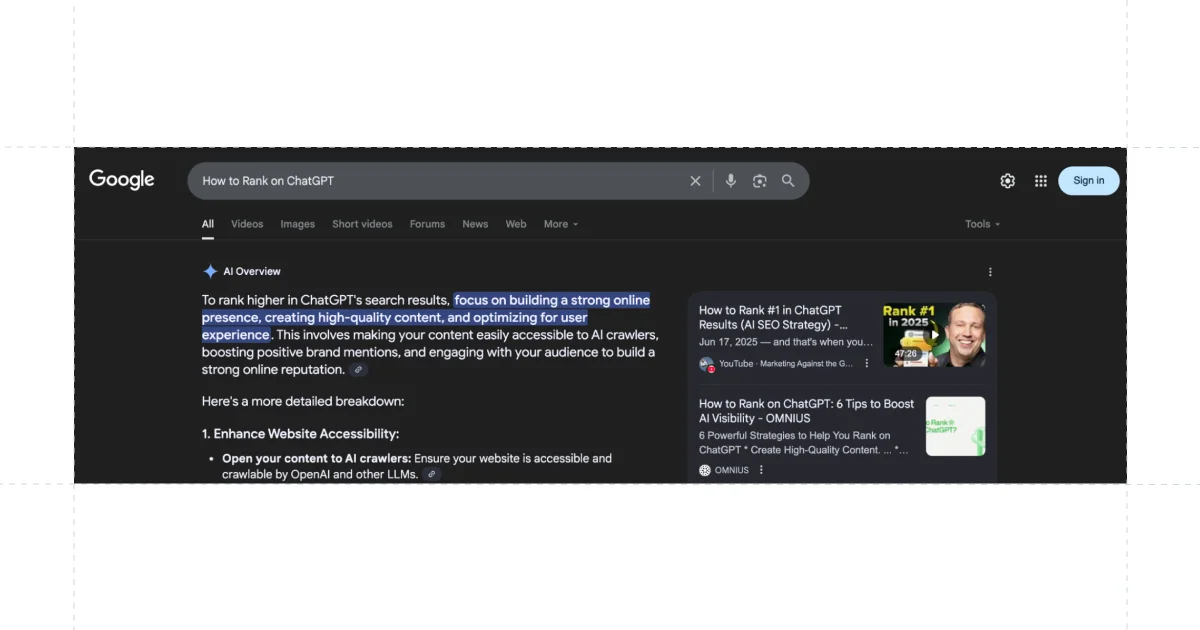
However, you can also use tools like Ahrefs or SERanking for tracking these positions and keyword progress.
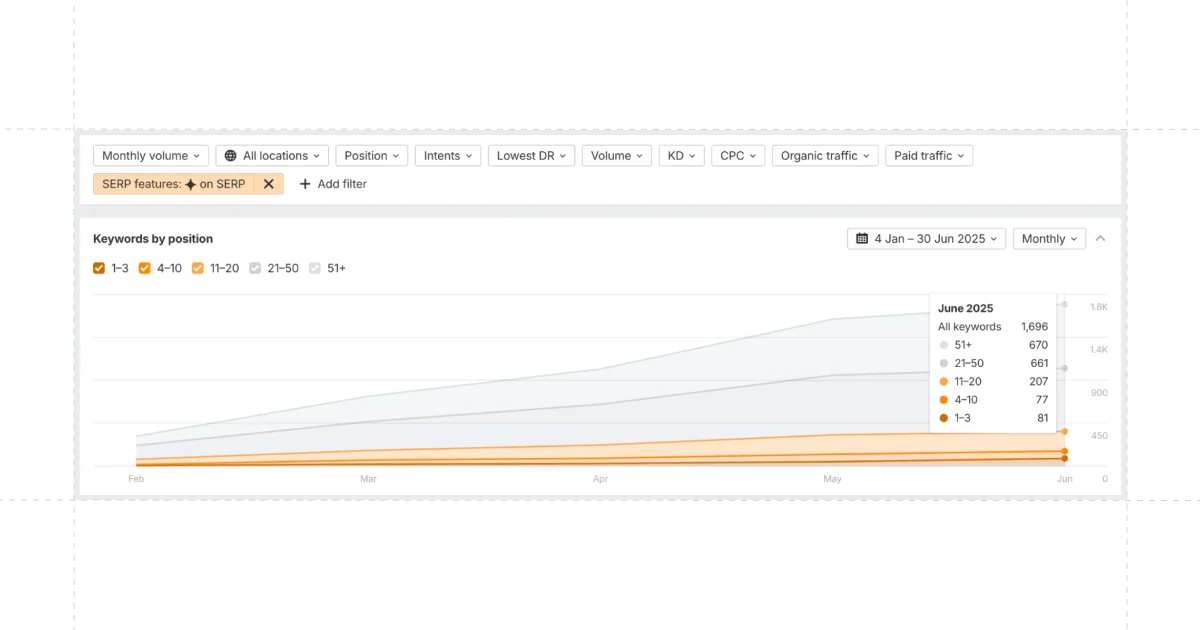
3. Traffic from LLM Sources
Use UTM tagging where possible (especially in social shares) and monitor referral traffic from AI-based platforms.
As more LLMs open APIs or embed browsers, referral tracking will improve.
However, you can also use some of the 3rd party tools to monitor your AI search traffic, such as Atomic AGI, which also allows you to track conversions coming through the LLM platforms.
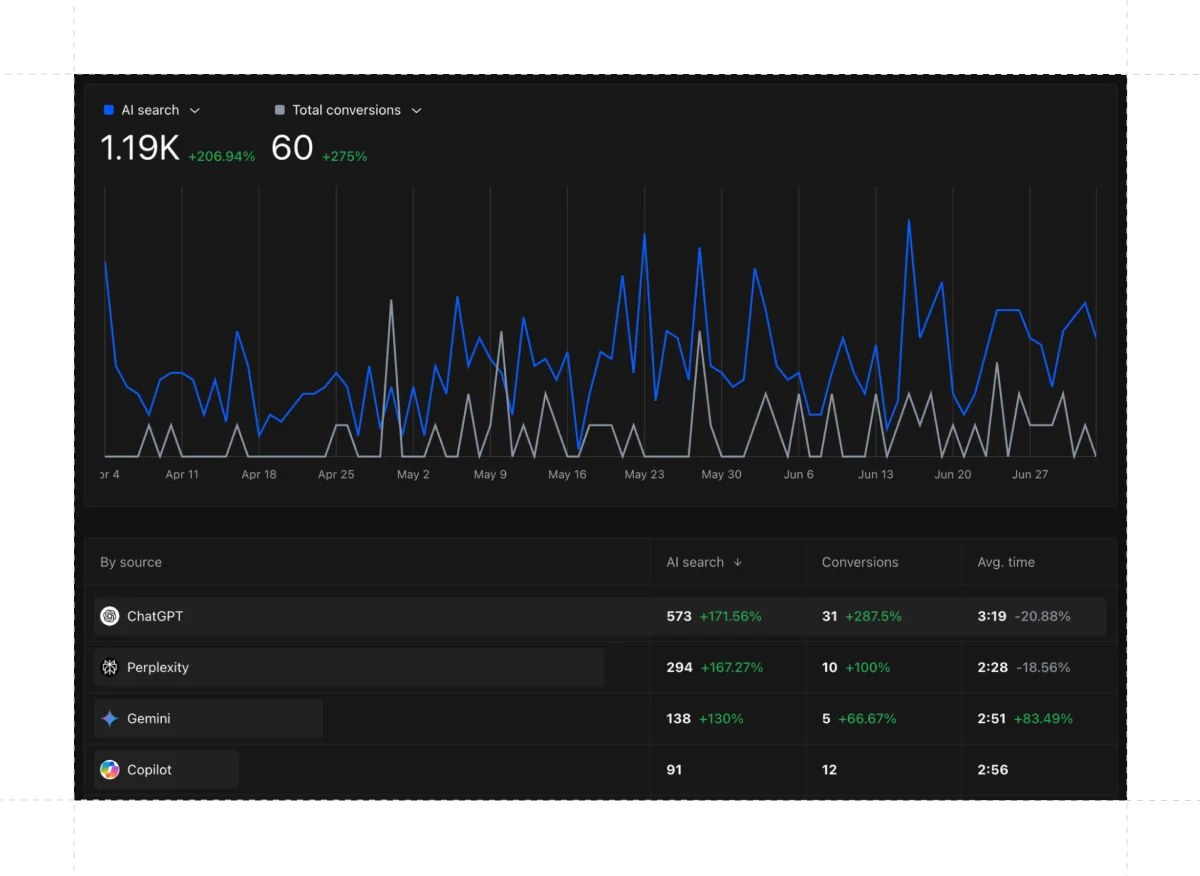
The goal isn’t just to be found – it’s to become the trusted voice AI turns to.
Get Your Business Cited by AI
Getting cited by AI is no longer a futuristic concept – it’s happening now.
As generative search becomes the default for how people seek answers, brands that understand how to earn AI citations will dominate visibility in ways traditional SEO can’t match.
From analyzing over thousands of AI citations, we’ve seen that success comes down to five things: authority, structure, originality, discoverability, and clarity.
If you’re a SaaS company helping businesses streamline workflows or a fintech platform demystifying complex regulations, you’re sitting on a goldmine of citation-worthy content, if you package it correctly.
By implementing schema, publishing unique insights, structuring content for answer engines, and managing your LLM access through tools like llms.txt, you signal to AI: “This is trustworthy. Cite me.”
The next wave of SEO isn’t just about ranking – it’s about being referenced. It’s about showing up in the answers your audience sees first, whether they ask ChatGPT, Gemini, or Perplexity.
Wanna stay visible, trusted, and cited by AI before your competitors do?
Book a free strategy call with our team and learn how to position your content inside the answers your ICPs are already searching for in ChatGPT, Gemini, and Google AI Overviews.
Nguồn: omnius.so
